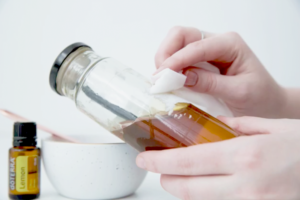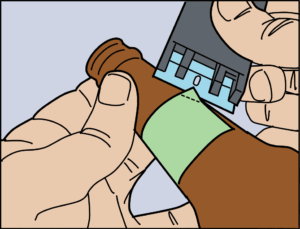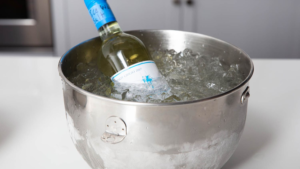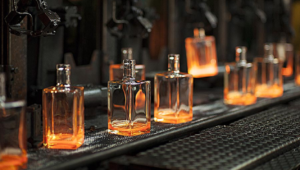Nowadays, people pay more attention to our environment. Sustainable develop, protect our earth is not only scientist’s jobs and slogan, but a job of a man in the street. We do what we can do to release zero-waste life.
To be environmentally friendly, people often reuse empty food glass jars to store home-made food, like hot sauce, jams, also use the jars to package DIY crafts. So we collect a lot of empty glass jars, large or small sizes, round or square shapes. Meanwhile we have a whole lot of trouble getting the sticky labels off. This article, we will introduce some easy but effective ways to remove the labels and glue residue from glass jars, using all-natural, eco-friendly ingredients you already in your home.
In search of empty glass bottles and jars with high quality, competitive prices, trust us as your reliable glass bottle supplier.
Table of Contents
ToggleWays To Remove Label Stickers
The feeling when a label peels off straightly without any ripping or sticky residue left behind is unlike any other, but for all the other items when it just won’t come off and your nails are ruined from scratching at it and your arms are sore from scrubbing, use one of these nine label removing methods.
Here following some solutions for peeling off the labels and cleaning the lingering smells.
Way 1. Hot Soapy Water, Baking Soda and Cooking Oil

Soak the jars in warm, soapy water and then peel the labels off. You can also try pouring hot water into the jar to heat the glue and make it easier to remove the labels.
Scrub the jars with a scourer to remove as much of whatever is left over as possible. This might be enough to get everything off some jars labels.
If there is any sticky residue left over on any of the jars, rub a mixture of equal amounts of baking soda and any cooking oil over the sticky part. Some Say it it better to leave this mixture on for 30 minutes before scrubbing it off and rinsing the jars, but others say you can just run the oil mixture over the sticky residue with your fingers for a few minutes and then wipe it off with a soft napkin or towel.
We’ve tried this method and it definitely works, however the jars are oily afterwards and it can be a pain getting rid of this oiliness.
Way 2. Using Essential Oil

After you have the label off, essential oils like eucalyptus essential oil, lemon essential oil, orange essential oil, and tea tree oil can be used to remove the sticky residue.
No soaking is needed most of the time. It should work straight away. Rub the essential oil on it with a rag and it should dissolve. The jar can then be rinsed, dried and used or stored.
A note on essential oils: they are generally not environmentally friendly to produce and some (tea tree oil and lavender oil) have been found to be endocrine disruptors and certain ones are toxic to dogs and cats, so we don’t recommend using these carelessly
Way 3. Using Alcohol

Anything with a high percentage of alcohol, such as methylated spirits, isopropanol, and nail polish remover, will also work well when it comes to removing any stickiness left over by labels and stickers. Put some on a rag or soak a rag in one of the above and rub the sticky spot until it is gone.
Way 4. Citrus-Based Cleaner

Citrus-based cleaners are another liquid substance that is good for getting glue off glass. Spray it on the glass jar and let it sit for a bit or soak the jar in a citrus cleaner and then scrub the parts of the jar that need some elbow grease to remove any leftover label or glue.
Way 5. Using White Vinegar

Another use for white vinegar, which is a staple cleaner in most zero waste households! It is said that white vinegar on a cloth gets adhesive stuck to glass jars off easily. If you’ve made a citrus peel vinegar cleaner, you will get the combined power of white vinegar and citrus.
Way 6. Heat In An Oven Or Microwave Or Using A Hairdryer

Putting jars in an oven for 10 minutes, in a microwave for a few minutes, or blowing them with hot air from a hairdryer heats and melts the glue used to stick labels to glass jars, making it easier to remove the paper label and the glue.
Way 7. A Razor Blade

You can shave leftover adhesive off using an old razor, a safety razor or a razor blade. Carefully scrape off any remaining stubborn bits after removing the label.
Way 8. Freezer Or Iced Water

Not only heating jars helps, it seems that freezing them works too! Apparently if you put a jar in a freezer with the lid off for the few hours, the label will come off easily. You could also try soaking it in ice water overnight, which is meant to remove the adhesive and label.
How To Getting Strong Smell Out
Some jars have stubborn smells it is hard to get rid of, especially pickle jars and ones that have held curry paste! Dishwashing and hand washing just aren’t enough to banish them! There are a few other things you can try to dispel the smell:
- use the power of the sun: leave it in direct sunlight on a windowsill or outside with the lid off for a day or two,
- put a bit of water and baking soda in the jar, put the lid on and shake it vigorously – the smell should be quelled pretty quickly as baking soda absorbs odours,
- use a lemon: wipe the jar with a cloth and lemon juice,
- sterilise them in the oven: wash them and then place them face up on a tray in the oven for a few minutes
- boil the jar in hot water with white vinegar.
FAQs About Removing Labels From Glass Bottles & Jars
Question 1: Is the dish soap and baking soda methos for removing labels environmentally friendly?
As long as you choose a mild dish soap that is highly rated by the Environmental Working Group, then using the dish soap and baking soda method to remove glass jar labels is the most eco-friendly and safe-for-you option compared to other cleaners (washing soda, rubbing alcohol, etc.).
Question 2: Can I use washing soda to remove labels?
You can use washing soda to remove sticky labels from glass jars. Simply replace the vinegar and/or baking soda in this how-to with washing soda.
However, though the Environmental Work Group gives washing soad an A rating for eco-friendly cleaning purposes, it is not edible and is caustic (meaning can burn your skin) so make sure to use cleaning gloves when handling.
Question 3: Can I use rubbing alcohol to remove labels?
Rubbing alcohol can be used to remove labels easily from jars, however it is not technically an eco-friendly ingredient.
While rubbing alcohol is a powerful disinfectant with many household uses, study warns that it may cause skin irritation if handling without gloves and serious harm if ingested, not to mention flammable.
For the purposes of removing labels, we suggest sticking with safe ingredients like dish soap and baking soda.
Question 4: Can I use a hair-dryer to remove labels?
You can use a hair dryer to blow hot air onto a food label to melt the glue, however you will still need to soak the jar in either water or use oil to remove the sticky label.
For this reason we recommend cutting out this step and going right to soaking in hot water with soap, vinegar, and baking soda, which will also help adhesive glue to easily rub off.
Question 5: Does remove labels with dish soap and vinegar damage glass?
Removing labels with dish soap and baking soda does not damage jars and they will be able to be used again for other household and food storage.
Question 6: Does the vinegar and dish soap method work on all labels?
Using dish soap and vinegar should remove all paper labels from beer, wine, champagne, and other types of jars. If sticky labels persist, make sure to use a combination of oil and baking soda to scrub off pesky paper labels.
Some screen printed labels like dates or on some beer bottle may need a stronger scrub brush to remove. However, if the label is etched into bottle then it is not possible to remove the label.
Ideas For What To Store In Your Newly Clean Jars
Now that your glass food and drink jars are clean and ready to use, here are some ideas to fill up reusable glass jar for a zero-waste container storage in your pantry and around the house.
- Use reusable glass jars to store homemade food scrap vegetable broth. After saving homemade food scraps and making broth, fill up empty glass jars with homemade vegetable broth made from food scraps and freeze until ready to use.
- Take your empty glass jars to the grocery store to fill in the bulk section. Fill up jars with pantry staples like rice and other grains, dried fruit, flour, sugar, nuts, seeds, and other foods instead of using plastic bags.
- Organize your pantry with glass jars. Take foods out of plastic or paper boxes and store in see-through glass jars for a clean pantry and to easily see which foods you have on hand. We’ve found that food that is visible gets eaten, so put food in jars to reduce its changes of being wasted.
- Organize your kitchen drawers with small glass jars. Use empty jars to store small bits and bobs in the kitchen, like coins, leftover bread ties, bag clips, etc. No more opening ten drawers to find your small kitchen items!
- Store laftover food in the fridge
- Give things to friends or family since it is OK it the jas doesnot come back to you




